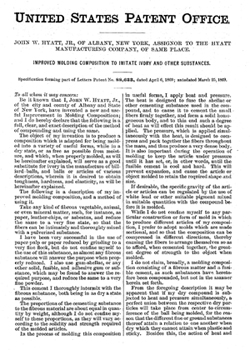 The first thermoplastic was exhibited in 1862 at the London International Exhibition. Parkesine was invented in 1855 in London by Alexander Parkes. Parkesine was an organic material made by dissolving cellulose nitrate in solvent. The material could supposedly do everything that rubber could do only it was cheaper. In 1866, Parkes formed the Parkesine Company to produce his plastic. It was not a commercial success though because it was expensive, easily cracked and highly flammable.
The first thermoplastic was exhibited in 1862 at the London International Exhibition. Parkesine was invented in 1855 in London by Alexander Parkes. Parkesine was an organic material made by dissolving cellulose nitrate in solvent. The material could supposedly do everything that rubber could do only it was cheaper. In 1866, Parkes formed the Parkesine Company to produce his plastic. It was not a commercial success though because it was expensive, easily cracked and highly flammable.
Celluloid, the first commercially successful industrial plastic, was invented for a surprising reason. Billiards had become a very popular game in the late part of the 19th century. At the time, billiard balls were produced from ivory and thousand of elephant were being killed to produce the game. A shortage of ivory was threatening the business of billiard ball makers, Phelan & Collander, so they offered a $10,000 reward for a substitute material.
 John Wesley Hyatt was one of the people who began working on finding this material. Hyatt’s first balls were produced using collodion. He had discovered this solution when a bottle spilled in his workshop and congealed into a tough film. The collodion, however, was very brittle so the balls would shatter when they hit each other. Experiments led Hyatt to discover that the addition of camphor to the collodion changed the properties and a new thermoplastic was born. Celluloid could be molded with heat and pressure and would hold its shape after the removal of the heat and pressure. On April 6, 1869, Hyatt received U.S Patent 88,633 for an Improved Molding Composition To Imitate Ivory And Other Substances.
John Wesley Hyatt was one of the people who began working on finding this material. Hyatt’s first balls were produced using collodion. He had discovered this solution when a bottle spilled in his workshop and congealed into a tough film. The collodion, however, was very brittle so the balls would shatter when they hit each other. Experiments led Hyatt to discover that the addition of camphor to the collodion changed the properties and a new thermoplastic was born. Celluloid could be molded with heat and pressure and would hold its shape after the removal of the heat and pressure. On April 6, 1869, Hyatt received U.S Patent 88,633 for an Improved Molding Composition To Imitate Ivory And Other Substances.
The $10,000 reward seems to have never been granted. Wyatt sent up his own manufacturing company and began produced billiard balls though. Later, Hyatt started the Albany Dental Plate Company for manufacturing dental plates. The company then began manufacturing other goods of celluloid including piano keys and knife handles. The name of the company was then changed to Celluloid Manufacturing Company.
An English inventor working with Parkes had also invented a new thermoplastic at the same time. Daniel Spill called his new plastic Xylonite. Spill believed that Hyatt’s patent infringed on his discovery and took him to court numerous times. The judge initially ruled in Spill’s favor in 1880. The ruling was overturned though in 1884 when Alexander Parkes was declared the inventor of man-made plastics.
